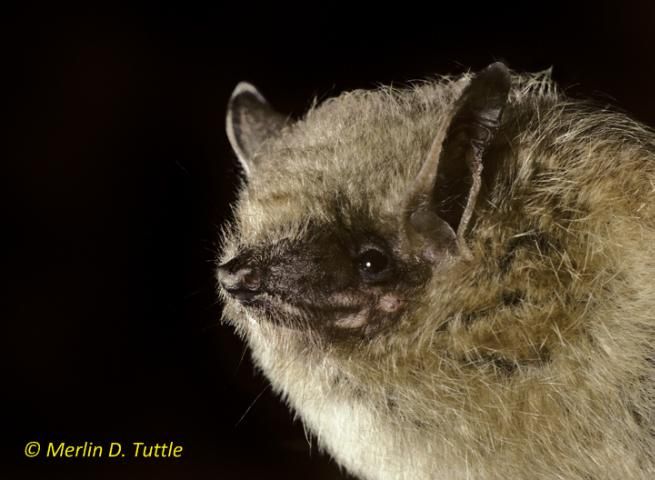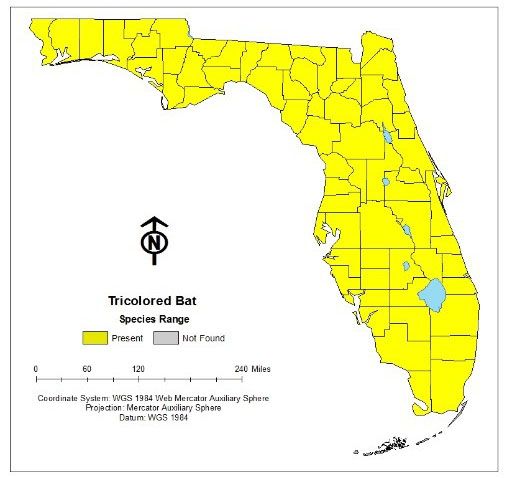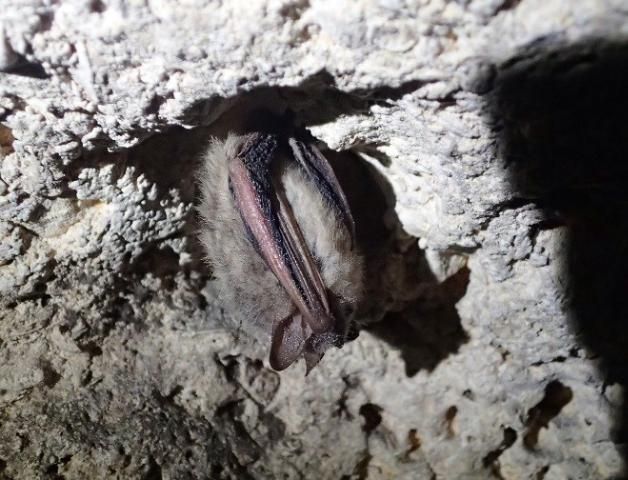The tricolored bat, formerly known as the eastern pipistrelle, is the smallest bat found in the state of Florida (Figure 1). It weighs just 0.3 ounces or 8 grams (the weight of a nickel and a penny) and has an approximately 9-inch (210–260 mm) wingspan. Due to their small size and erratic flight pattern, tricolored bats are often mistaken for moths when seen in flight from a long distance away.

Credit: Merlin Tuttle, Merlin Tuttle's Bat Conservation
Tricolored bats are found throughout the eastern United States and Central America and are known to occur in most areas of Florida, with the exception of the Keys (Figure 2). Since they are rarely encountered within the state, tricolored bats are considered uncommon in Florida.

This species is considered one of the more colorful species of bats in the state. They have pinkish forearms (the bones that support the wings), black wing membranes, and fur ranging from silver-yellow to dark orange. The name refers to the three colors (black, yellow, and brown) found on individual hairs on the bat's body (Figure 3).

Credit: Jeff Gore, FWC
Tricolored bats typically roost (sleep during the day) alone, especially in the winter months, when they are known to hibernate almost exclusively in caves. The tricolored bat is one of only three species of bats in Florida that hibernate in caves during the winter. Across North America, many bats that hibernate in caves are susceptible to a deadly disease called white nose syndrome (WNS). This disease has killed many millions of cave-dwelling bats across eastern North America since it first appeared in 2006. White nose syndrome is caused by a fungus that has not been found in Florida caves to date. Biologists are carefully monitoring Florida's caves so they will know if WNS appears.
In the summer months, tricolored bats often roost in the foliage of trees, in tree cavities, in Spanish moss, and in old buildings. Females cluster in small groups to birth and rear young (May–June). Within this time period, which is often referred to as the maternity season, twin pups are born and then weaned approximately four weeks after birth.
Tricolored bats, like most of Florida's bats, are insectivorous and forage at night. They feed on small moths, beetles, flies, leafhoppers, and flying ants.
Distinguishing the Tricolored Bat from Similar Florida Bat Species
Tricolored bats can be distinguished from other species in part by their size: adults are a mere 1.5–2 inches (36–52 mm) from head to rump. Their unusual coloring is also distinctive, with black wing membranes contrasting sharply with pink forearm bones (other species have wing membranes that more closely match the forearm bones in color).
Read below to determine how to differentiate tricolored bats from other similar species found in Florida.
Tricolored Bat
- Fur ranges dramatically in color among individuals from pale silver-yellow to dark orange.
- Wing membranes are blackish and contrast sharply with wing bones, which are pink.
- The body is very small, less than 2 inches (36–52 mm) from head to rump.
- Small forearm is approximately 1 1/3 inches (31–36 mm).
- Bats roost singly or in small groups of 2–3 in caves, tree cavities and foliage, Spanish moss, and buildings.
- They may share roosts with Brazilian free-tailed bats, evening bats, and southeastern myotis bats.
- Bats forage along tree lines and over ponds and streams throughout the state.
Southeastern Myotis
- Fur ranges from gray to brown to reddish on the back and buff to tan on the stomach.
- Wing membranes are dark brown, as are wing bones, and the muzzle is mostly furred.
- The base of each wing is attached to the inner toe of each foot.
- Long hairs between the toes extend past the claws.
- The body is small, approximately 2 inches (48–53 mm) from nose to rump.
- Bats roost in colonies larger in size than tricolored bat colonies (typically ranging from 100 to 10,000) in caves and tree cavities, beneath concrete bridges and culverts, and in houses and bat houses.
Evening Bat
- Fur is brown to dark brown on the back and buff to tan on the stomach.
- The bat resembles the big brown bat but is much smaller.
- Wing membranes are dark brown, as are wing bones; ears and muzzle are unfurred.
- The body is small, approximately 2.3 inches (49–67 mm) from nose to rump.
- Bats roost in fairly small groups numbering up to 100 individuals in tree cavities, beneath tree bark, in concrete bridges, beneath caps on top of utility poles, in folded patio umbrellas, in houses, and in bat houses.
- They may share roosts with Brazilian free-tailed bats and southeastern myotis.
- Bats forage in many habitat types throughout the state.
Additional Information
Florida Fish and Wildlife Conservation Commission. Living with bats.
Marks, C. S., and G. E. Marks. 2006. Bats of Florida. University Press of Florida. Gainesville, Fl. 176 pp.
Ober, H. K., M. B. Main, and G. M. Allen. 2004. Bats of Florida. WEC186. Gainesville: University of Florida Institute of Food and Agricultural Sciences. https://edis.ifas.ufl.edu/publication/uw203
Ober, H. K. and F. J. Mazzotti. 2008. Conservation of Bats in Florida. WEC247. Gainesville: University of Florida Institute of Food and Agricultural Sciences. https://edis.ifas.ufl.edu/publication/uw291
Ober, H. K. 2008. Effective Bat Houses for Florida. WEC246. Gainesville: University of Florida Institute of Food and Agricultural Sciences. https://edis.ifas.ufl.edu/uw290
Ober, H. K. 2008. Insect Pest Management Services Provided by Bats. WEC245. Gainesville: University of Florida Institute of Food and Agricultural Sciences. https://edis.ifas.ufl.edu/publication/uw289
Wisely, S. M., and H. K. Ober. 2015. Facts about Wildlife Diseases: Rabies. WEC239. Gainesville: University of Florida Institute of Food and Agricultural Sciences. https://edis.ifas.ufl.edu/uw282